Comprehensive Analysis of the Expression and Prognosis for ITGBs: Identification of ITGB5 as a Biomarker of Poor Prognosis and Correlated with Immune Infiltrates in Gastric Cancer
- PMID: 35223869
- PMCID: PMC8863963
- DOI: 10.3389/fcell.2021.816230
Comprehensive Analysis of the Expression and Prognosis for ITGBs: Identification of ITGB5 as a Biomarker of Poor Prognosis and Correlated with Immune Infiltrates in Gastric Cancer
Abstract
Background: Integrin β superfamily members (ITGBs) are documented to play important roles in various biological processes, and accumulating evidence suggests that ITGBs are associated with carcinogenic effects in several malignancies. Gastric cancer (GC) is a complicated and highly heterogeneous disease; however, the expression and prognostic values of eight ITGBs and potential mechanism in GC remain largely unclear. Methods: The expression and prognostic significance of ITGBs in GC were systematically analyzed through Gene Expression Profiling Interactive Analysis, Human Protein Atlas, Kaplan-Meier Plotter, and cBioPortal databases. Then, the mRNA transcription data and corresponding clinical data of GC were downloaded from the Gene Expression Omnibus database as a testing cohort, and differentially expressed and prognostic genes were identified. The correlation between ITGB5 expression and overall survival and various clinical parameters were found by using univariate/multivariable Cox regression and Kaplan-Meier survival analysis. Additionally, differential analysis of gene expression profiles in low- and high-ITGB5 expression groups and pathway enrichment analysis was performed. Finally, the correlation of ITGB5 expression with immune infiltrates in GC was clarified. Results: Compared with adjacent normal tissue, the results reveal that the mRNA levels of ITGB1-2 and ITGB4-8 are significantly higher in GC, and immunohistochemistry results show the consistency between RNA and protein expression levels. Cox regression and Kaplan-Meier survival analysis indicate that high ITGB5 expression contributes to a poor prognosis and could be an independent prognostic factor in GC patients. Besides this, gene functional enrichment analysis indicates that ITGB5 expression is significantly associated with extracellular matrix organization, cell-substrate adhesion, and ossification. The KEGG pathway analysis of ITGB5 shows a close association between ITGB5 and focal adhesion, ECM-receptor interaction, phagosome, and PI3K-Akt signaling pathway. Last, the infiltrating level of CD4+ T cells, macrophages, and dendritic cells are positively related to the expression of ITGB5, especially macrophages, and lower levels of macrophages predict a better prognosis in GC in our study. Conclusion: Our findings investigate that ITGB5 may function as a valid biomarker of prognosis, and high expression of ITGB5 predicts poor prognosis for patients with GC. Besides this, it might be a potential target of precision therapy against GC.
Keywords: ITGB5; ITGBs; gastric cancer; immune infiltrate; prognosis.
Copyright © 2022 Liu, Liu, Fang, Liu and Hu.
Conflict of interest statement
The authors declare that the research was conducted in the absence of any commercial or financial relationships that could be construed as a potential conflict of interest.
Figures
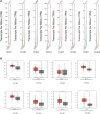




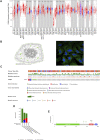
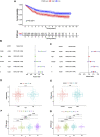


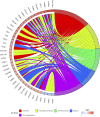
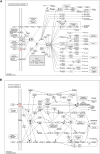



Similar articles
-
Integrin β5, a noninvasive diagnostic biomarker, is associated with unfavorable prognosis and immunotherapy efficacy in gastric cancer.BMC Gastroenterol. 2024 Oct 11;24(1):362. doi: 10.1186/s12876-024-03447-w. BMC Gastroenterol. 2024. PMID: 39394072 Free PMC article.
-
Characterization of the prognostic and oncologic values of ITGB superfamily members in pancreatic cancer.J Cell Mol Med. 2020 Nov;24(22):13481-13493. doi: 10.1111/jcmm.15990. Epub 2020 Oct 18. J Cell Mol Med. 2020. PMID: 33073486 Free PMC article.
-
The prognostic and immune infiltration role of ITGB superfamily members in non-small cell lung cancer.Am J Transl Res. 2022 Sep 15;14(9):6445-6466. eCollection 2022. Am J Transl Res. 2022. PMID: 36247270 Free PMC article.
-
COL5A2 is a prognostic-related biomarker and correlated with immune infiltrates in gastric cancer based on transcriptomics and single-cell RNA sequencing.BMC Med Genomics. 2023 Sep 18;16(1):220. doi: 10.1186/s12920-023-01659-9. BMC Med Genomics. 2023. PMID: 37723519 Free PMC article.
-
Systems biology and OMIC data integration to understand gastrointestinal cancers.World J Clin Oncol. 2022 Oct 24;13(10):762-778. doi: 10.5306/wjco.v13.i10.762. World J Clin Oncol. 2022. PMID: 36337313 Free PMC article. Review.
Cited by
-
Combination of single-cell and bulk RNA seq reveals the immune infiltration landscape and targeted therapeutic drugs in spinal cord injury.Front Immunol. 2023 Jan 19;14:1068359. doi: 10.3389/fimmu.2023.1068359. eCollection 2023. Front Immunol. 2023. PMID: 36742334 Free PMC article.
-
Preclinical evaluation of oncolytic potential human rotavirus Wt 1-5 in gastric adenocarcinoma.PLoS One. 2023 May 15;18(5):e0285543. doi: 10.1371/journal.pone.0285543. eCollection 2023. PLoS One. 2023. PMID: 37186587 Free PMC article.
-
Clinical significance of integrin αV and β superfamily members and focal adhesion kinase activity in oral squamous cell carcinoma: a retrospective observational study.Pathol Oncol Res. 2024 Jan 18;30:1611571. doi: 10.3389/pore.2024.1611571. eCollection 2024. Pathol Oncol Res. 2024. PMID: 38312516 Free PMC article.
-
Integrin β5 interacts with G3BP1 through activating FAK/Src signaling pathway to promote gastric carcinogenesis.Sci Rep. 2025 Aug 5;15(1):28633. doi: 10.1038/s41598-025-14067-z. Sci Rep. 2025. PMID: 40764649 Free PMC article.
-
A Novel Gene List Identifies Tumors with a Stromal-Mesenchymal Phenotype and Worse Prognosis in Gastric Cancer.Cancers (Basel). 2023 Jun 2;15(11):3035. doi: 10.3390/cancers15113035. Cancers (Basel). 2023. PMID: 37296997 Free PMC article.
References
LinkOut - more resources
Full Text Sources
Research Materials
Miscellaneous

